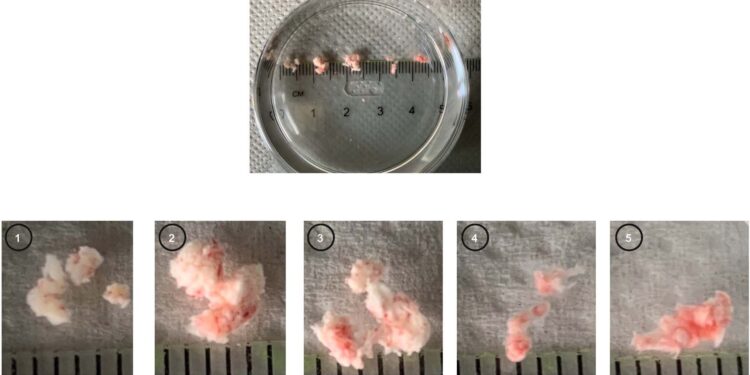Example of research samples collected from a patient with supratentorial MCC. Credit: Natural medicine (2023).
Researchers from Helmholtz Munich and LMU have discovered that in case of brain damage, specific cells in the brain become active in pathological situations and exhibit the properties of neural stem cells.
The authors further discovered that a specific protein regulates these cells and could therefore serve as a therapeutic target and thus contribute to better treatments of brain injuries in the future. The new findings highlight the specificity of astrocyte response under different injury conditions and the results are published in Natural medicine.
The onset and progression of neurological disorders, such as trauma, stroke, epilepsy, and various neurodegenerative diseases, lead to irreversible loss of neurons leading to severe alterations in brain functions. Although the prevalence of these disorders is steadily increasing worldwide, effective treatment options are still lacking.
Treatment options are very limited due to the fact that lost neurons cannot be replaced and the injury environment may not promote healing.
However, previous preclinical research has revealed a promising answer involving a specific type of glial cells, an essential component of the nervous system alongside neurons, known for their role in supporting and protecting neurons, star-shaped astrocytes. . They demonstrated the ability to resume cell proliferation, a crucial mechanism to protect the affected brain from immune cell invasion. Additionally, some of these astrocytes acquire neural stem cell properties.
Stem cells are cells that self-renew and can generate different types of cells in an organ. Thus, neural stem cells can self-renew and generate neurons and glial cells. These cells have been detected in the murine brain after injuries such as trauma or stroke, which are diseases in which the blood-brain barrier (BBB) is disrupted and blood or cerebrovascular fluid spinal cord, a protective fluid surrounding the brain, can penetrate.
Distinct astrocyte response reveals new biomarkers and source of repair in human brain
Scientists led by Professor Magdalena Götz from Helmholtz Munich and Ludwig-Maximilians-Universität München (LMU) have revealed that in the adult human brain, astrocytes begin to proliferate and acquire neural stem cell properties once disease-related disruption of the BBB occurs, and that this pathology-specific plasticity of astrocytes at the site of injury is closely correlated with the upregulation of a protein called Galectin 3 serving as a novel marker for proliferation human astrocytes.
Dr. Swetlana Sirko, first author of the study, further explains: “Given the importance of astrocyte proliferation in clinical assessments of the neuropathological state of patients, our results are diagnostically relevant, but also add to our understanding of how diagnostic-specific changes in cerebrospinal fluid composition, and in particular an upregulation of galectin-binding protein 3 (LGALS3BP), support the maintenance of astrocyte plasticity in the brain human.
“Despite the exact mechanisms remaining to be elucidated, the identification of the Galectin 3-LGALS3BP axis as an inducer of astrocyte plasticity could greatly contribute to the discovery of biomarkers for the prediction of proliferative astrogliosis and their beneficial modulation in the affected brain parenchyma.”
By discovering two essential regulators of astrocyte proliferation following injury, the researchers laid the cornerstone for the future clinical applicability of these biomarkers as potential indicators to detect a beneficial glial cell response, but more importantly identified the presence of cells with stem cell potential in the brains of patients.
The study highlights the importance of understanding the response of glial cells to injury. Magdalena Götz, corresponding author of the study, says: “Our analysis with this supposedly annoying supporting cell type has now shown the presence of neural stem cells in the brains of trauma or stroke patients. . This is an exciting new cellular source to replace lost neurons. “.
More information:
Swetlana Sirko et al, Injury-specific factors in cerebrospinal fluid regulate astrocyte plasticity in the human brain, Natural medicine (2023). DOI: 10.1038/s41591-023-02644-6
Provided by the Helmholtz Association of German Research Centers
Quote: Researchers discover potential source of stem cells in the brains of patients affected by injury (December 8, 2023) retrieved December 8, 2023 from
This document is subject to copyright. Apart from fair use for private study or research purposes, no part may be reproduced without written permission. The content is provided for information only.



